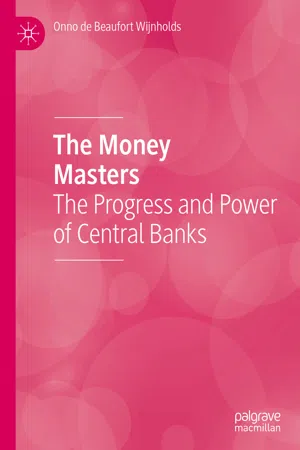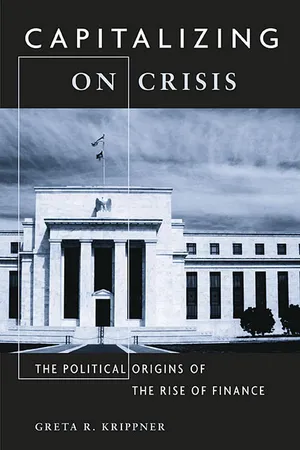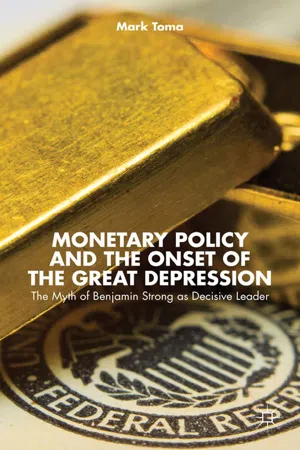Discretionary Monetary Policy
Discretionary monetary policy refers to the deliberate actions taken by a central bank to influence the economy through changes in interest rates, reserve requirements, and open market operations. This policy is implemented in response to current economic conditions and is not based on predetermined rules or formulas. It allows central banks to adjust their strategies in real time to address economic challenges.
4 Key excerpts on "Discretionary Monetary Policy"
- eBook - ePub
Contemporary Economics
An Applications Approach
- Robert Carbaugh(Author)
- 2016(Publication Date)
- Routledge(Publisher)
...However, this does not guarantee that banks will actually make loans. If businesses are pessimistic about future profits, they may be unwilling to borrow excess reserves, thus frustrating the expansionary monetary policy. Discretion or Rules: Fixed Money Rule or Inflation Targeting The weaknesses of monetary policy highlight a debate concerning the conduct of monetary policy. Should the Fed be free to use its own discretion to stabilize the economy, or should it be limited to following rules? And if the Fed should follow rules, what kind of rules? The case for Discretionary Monetary Policy is founded on the notion that the economy is constantly affected by recessionary or expansionary forces. Without an active monetary policy, based on the judgments of the Fed about the current needs of the economy, it is feared that the economy would oscillate in unacceptably wide swings. To decrease such instability, proponents maintain that the Fed can stimulate the economy when it becomes sluggish or restrain the economy when it overheats. However, critics say that discretionary changes in the money supply by the Fed may actually destabilize the economy. They note that the Fed does not have up-to-the-minute, reliable information about the state of the economy and prices. Information is limited because of lags in the publication of data. Also, the Fed has a less-than-perfect understanding of the way the economy works, including the knowledge of when and to what extent policy actions will affect aggregate demand. These limitations add to uncertainties in the policy process and make determining the appropriate setting of monetary policy instruments more difficult. Rather than using its own discretion to conduct monetary policy, the Fed might adopt a fixed-rule policy independent of the state of the economy...
- eBook - ePub
The Money Masters
The Progress and Power of Central Banks
- Onno de Beaufort Wijnholds(Author)
- 2020(Publication Date)
- Palgrave Macmillan(Publisher)
...Discretionary Monetary Policy is forward looking and data driven. It does not depend on following the development of a single economic variable such as the money supply, but considers a range of factors reflecting the state of the economy, on the one hand through its econometric forecasting models, on the other hand based on a more judgmental interpretation of the data. Many of the variables are readily available, but others are not measurable and involve considerable guesswork. Economic growth, the rate of inflation, wages and unemployment, as well as the growth of productivity are readily available data, as is the capacity utilization in industry, although interpretation of such data is not always obvious. Inflation can be measured in various ways (headline vs. core), but more importantly, the extent to which changes in the price level are temporary or more permanent is notoriously difficult to gauge. A case in point is the price of energy which represents an important element in the measurement of headline inflation. Looking at core inflation (excluding energy and food) is the way this problem is usually addressed. Since the outlook for inflation is of central importance, the Fed (mainly through the regional reserve banks) conducts surveys of inflation expectations. The process involves inquiring about the expectations of consumers with respect to inflation, both in the short term and longer run, as well as of professional forecasters. In addition, the difference between the nominal yield on Treasury bonds and the real yield on inflation indexed bonds issued by the Treasury (TIPS) is regarded as an indicator of market sentiment. Finally, surveys are conducted to gauge inflation perspectives by asking respondents’ views regarding present and past inflation rates...
- eBook - ePub
Capitalizing on Crisis
The Political Origins of the Rise of Finance
- Greta R. Krippner(Author)
- 2012(Publication Date)
- Harvard University Press(Publisher)
...The monetarist experiment was beset with problems, however, and it quickly unraveled, but in later years policymakers would continue their efforts to govern the economy “at a distance” through varied techniques (Rose and Miller 1992). In the following pages, I analyze the evolution of monetary policy after monetarism was abandoned in 1982, tracing policymakers’ attempts to enlist market mechanisms to avoid responsibility for economic management. Paradoxically, these efforts have continually revisited the same dilemma on policymakers: transferring policy implementation, and its attendant political risks, to the market has successfully deflected attention away from the active role of policymakers in guiding the economy, but it has also in varying degrees compromised policymakers’ control of policy (cf. Burnham 2001). As this chapter shows, and consistent with what we observed in earlier chapters, the Federal Reserve’s efforts to depoliticize its activities by turning to the market has placed control over the expansion of credit in the hands of a particularly lax master, creating conditions conducive to the financialization of the economy. A Primer on Central Banking Monetary policy is one of the least accessible domains of economic policymaking. Thus, in this section, I explain precisely how the Federal Reserve implements monetary policy, providing the necessary technical background for understanding the following narrative. 2 (Readers who are already well versed in the intricacies of monetary policy may want to proceed directly to the historical analysis.) The Federal Reserve exercises a number of functions in the economy, but the most important is using monetary policy to smooth fluctuations in the business cycle. 3 In pursuing economic stabilization, the Federal Reserve attempts to influence economic activity by changing the level of interest rates...
- eBook - ePub
Monetary Policy and the Onset of the Great Depression
The Myth of Benjamin Strong as Decisive Leader
- M. Toma(Author)
- 2013(Publication Date)
- Palgrave Macmillan(Publisher)
...C H A P T E R 4 M ODELING D ISCRETION AND S ELF -R EGULATION 1. I NTRODUCTION The last chapter catalogued the evolution of the Fed as discretionary policy activist, interpreted from the Monetarist and Austrian perspectives. Both camps emphasized the Fed’s tendency to expand Fed credit, appropriately so, according to the Monetarists; excessively so, according to the Austrians. An interesting way to recast the policy activist theme is in terms of an interest rate smoothing objective. Indeed, Friedman and Schwartz devote an entire section, “Seasonal Movements,” in their “High Tide” chapter to documenting the Fed’s attempt to smooth interest rates. Their analysis is insightful and worth quoting at length: Before the Federal Reserve System was established, there had been recurrent ease in the money market in the summer and tightness in the fall crop-moving season and in the Christmas season September through December. One aspect of the seasonal movement was a fluctuation in the ratio of deposits to currency, which produced recurrent ease and tightness in bank reserve positions and a sharp seasonal pattern in call money and other short-term interest rates. That seasonal movement was very much in the minds of the founders of the System and was an important source of their belief in the need for an “elastic” currency . . . The Federal Reserve System met the seasonal movements by expanding and contracting high-powered money sufficiently to provide for the changed ratio of deposits to currency and also to permit a seasonal movement in the total stock of money. It thereby largely eliminated the recurrent seasonal ease and tightness in bank reserve positions, and hence the seasonal movement in interest rates (Friedman and Schwartz 1971, 292, 294). Friedman and Schwartz give their stamp of approval to the Fed’s interest rate smoothing policy...



